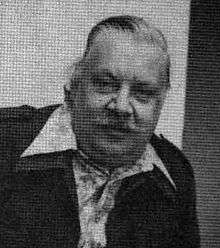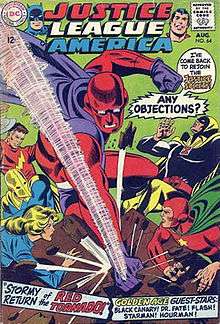Dick Dillin
| Dick Dillin | |
|---|---|
 Dick Dillin, from The Amazing World of DC Comics #11 (March 1976). | |
| Born |
Richard Allen Dillin December 17, 1928 Watertown, New York |
| Died | March 1980 (aged 51) |
| Nationality | American |
| Area(s) | Penciller |
Notable works |
Blackhawk Justice League of America World's Finest Comics |
Richard Allen "Dick" Dillin[1] (December 17, 1928 – March 1980)[2] was an American comic book artist best known for a 12-year run as the penciler of the DC Comics superhero-team series Justice League of America. He drew 115 issues from 1968 until his death in 1980.
Early life and career

Dick Dillin was born in Watertown, New York.[3] Determined since childhood to draw for comics, Dillin graduated from Watertown High School to become an art student at Syracuse University on the G.I. Bill, following his military service with the 8th U.S. Army in Tokyo, Yokohama, and Okinawa.[3] Sometime after marrying wife Estella in 1948, Dillin left his job at a Watertown manufacturer of air brakes for trains, and sought an art career in New York City. Six months later, after having done magazine illustration and other commercial art and gaining a foothold at Fawcett Comics and Fiction House, he relocated his family to suburban Peekskill, New York.
Dillin's art at Fawcett (on features including "Lance O'Casey" and "Ibis the Invincible" in Whiz Comics) and Fiction House ("Buzz Bennett", "Space Rangers") led to drawing for Quality Comics, beginning in 1952. He worked particularly on the popular title Blackhawk but also on G.I. Combat, Love Confessions, and Love Secrets.[4] When Quality went out of business, Dillin, searching for new work, eventually tried DC Comics where he saw one or more issues of Blackhawk on the desk as he was being interviewed, and to his relief was told, "We've been trying to get in touch with you."[5]
DC Comics

Dillin returned to Blackhawk, now a DC property, and when the book's initial run ended, went on to draw issues of World's Finest Comics and Batman specials before being assigned Justice League of America, a superteam series featuring, at the time, Superman, Batman, Green Lantern, Wonder Woman, Green Arrow, and the Atom. Dillin penciled the series from #64-183 (Aug. 1968 - Oct. 1980), except for the planned reprint issues #67, 76, 85 and 93; issue #153 which was pencilled by George Tuska; and issue #157 where he provided the intro and epilogue pages while Juan Ortiz pencilled the main story.[4][6] He had completed the first 2½ pages of #184 when he died; penciler George Pérez and inker Frank McLaughlin took over the title, starting that issue from scratch.
Dillin's tenure on JLA included the reintroduction of Red Tornado. He and writer Dennis O'Neil made several changes to the membership of the JLA by removing founding members Wonder Woman and the Martian Manhunter.[7] They also oversaw the migration of the Black Canary from Earth-2 to Earth-1; and the introduction of the JLA satellite. Dillin and writer Len Wein produced the return of the Seven Soldiers of Victory in issues #100-102[8] and the introduction of the Quality Comics characters to the DC continuity as the Freedom Fighters in issues #107-108.[9]
In the fall of 1972, Dillin drew the DC chapter of a metafictional unofficial crossover crafted by writers Wein, Steve Englehart, and Gerry Conway spanning titles from both major comics companies. Each comic featured Englehart, Conway, and Wein, as well as Wein's first wife Glynis, interacting with Marvel or DC characters at the Rutland Halloween Parade in Rutland, Vermont. Beginning in Amazing Adventures #16 (by Englehart with art by Bob Brown and Frank McLaughlin), the story continued in Justice League of America #103 (by Wein, Dillin and Dick Giordano), and concluded in Thor #207 (by Conway and penciler John Buscema).[10][11][12]
Wein and Dillin created the supervillain Libra in Justice League of America #111 (June 1974),[13] who would play a leading role in Grant Morrison's Final Crisis storyline in 2008. Dillin drew the return of Wonder Woman to the team in issues #128-129 (March–April 1976).[14] He and writer Steve Englehart crafted a new origin story for the JLA in issue #144[15] and inducted Hawkgirl into the team two issue later.[16] Other highlights of Dillin's tenure included the 1976 integration of the defunct and newly acquired Fawcett Comics heroes in issues #135-137, and the murder of the original Mister Terrific in issue #171.[17] Dillin and writer Bob Haney created the Super-Sons, Superman Jr. and Batman Jr., in World's Finest Comics #215 (Jan. 1973).[18] He drew several Green Lantern backup stories in The Flash from 1974 to 1977.[19] In 1975, Dillin drew the framing chapters for a 1940s Seven Soldiers of Victory script in Adventure Comics #438 and 443.[20][21][22]
He was living in Peekskill, New York, at the time of his death.[2]
Bibliography
Comics work (interior pencil art) includes:
DC
- Action Comics (Green Arrow) #424, 426, 431, 434, 436; (The Atom): #425, 427, 430, 433, 435, 438-439, 448; (Private Life of Clark Kent): #477 (1973–77)
- Atom and Hawkman #40-45 (1968–69)
- Adventure Comics (Seven Soldiers of Victory): #438, 443 (1975–76)
- Batman #246 (with Irv Novick); (Robin): #252, 254 (1972–73)
- Blackhawk #108-241 (1957–68)
- Challengers of the Unknown #72 (1970)
- DC Comics Presents #7, 13-14, 18, 22, 25 (1979–80)
- DC Special Series (Aquaman): #1 (1977)
- DC Super-Stars #10 (1976)
- Detective Comics (Batman) #433, 483; (Hawkman): #428 (1972–78)
- The Flash (Kid Flash) #202, 204, 207, 209, 211, 216 (1970–72); (Green Lantern): #227-228, 230-231, 233-234, 245-246 (1974–77)
- Green Lantern, vol. 2, #67, 71 (1969)
- Hawkman #22-27 (1967–68)
- House of Mystery #197 (1971)
- House of Secrets #82, 84, 87-88, 92, 96 (1969–72)
- Justice League of America #64-66, 68-75, 77-84, 86-92, 94-152, 154-183 (1968–80)
- Spectre (Hourman) #7 (1968)
- Superman (Terra-Man): #249; (Fabulous World of Krypton): #257, 263, 266, 268 (1972–73)
- The Unexpected #121-123, 126, 131, 133, 163, 165 (1970–75)
- The Witching Hour #26 (1972)
- Wonder Woman #217 (1975)[23]
- World's Finest Comics (Superman team-ups): #198-205, 207-228, 231-233, 235-236, 238, 240, 257; (Green Arrow): #256 (1970–79)
Collected editions
- Justice League of America Archives
- Volume 8 collects Justice League of America #64-66, 68-70 ISBN 978-1563899775
- Volume 9 collects Justice League of America #71-80 ISBN 978-1401204020
- Volume 10 collects Justice League of America #81-93 ISBN 978-1401234126
- Showcase Presents Justice League of America
- Volume 4 collects Justice League of America #64-66, 68-75, 77-83 ISBN 978-1401221843
- Volume 5 collects Justice League of America #84, 86-92, 94-106 ISBN 978-1401230258
- Volume 6 collects Justice League of America #107-132 ISBN 978-1401238353
- Crisis on Multiple Earths
- Volume 2 collects Justice League of America #64-65, 73-74, and 82-83 ISBN 978-1401200039
- Volume 3 collects Justice League of America #91-92, 100-102, 107-108, and 113 ISBN 978-1401202316
- Volume 4 collects Justice League of America #123-124, 135-137, and 147-148 ISBN 978-1401209575
- Volume 5 collects Justice League of America #159-160, 171-172, and 183 ISBN 978-1401226237
Quality
- Blackhawk #37, 40, 64-65, 67-107 (1951–56)
- Plastic Man #45 (1954)
Other work
Dillin drew animation storyboards for the Trans-Lux/Joe Orolio syndicated TV series Johnny Zero (c. 1962), and The Mighty Hercules (1963), among other shows.[1]
References
- 1 2 Bails, Jerry (2006). "Dillin, Dick". Who's Who of American Comic Books 1928-1999. Retrieved September 21, 2012.
- 1 2 Richard Dillin at the United States Social Security Death Index via FamilySearch.org. Retrieved on February 23, 2013. Also: Richard Dillin at the United States Social Security Death Index via GenealogyBank.com. Retrieved on January 8, 2016.
- 1 2 "Dick Dillin". Lambiek Comiclopedia. 2006. Archived from the original on October 18, 2011. Note: Source erroneously gives birth year as 1929
- 1 2 Dick Dillin at the Grand Comics Database
- ↑ "Interview with the family of Dick Dillin". Alter Ego (30). Raleigh, North Carolina: TwoMorrows Publishing. November 2003.
- ↑ Riley, Shannon E. (August 2012). "22,300 Miles Above Earth: A Look Back at the JLA's 'Satellite Years'". Back Issue!. Raleigh, North Carolina: TwoMorrows Publishing (58): 18.
- ↑ McAvennie, Michael; Dolan, Hannah, ed. (2010). "1960s". DC Comics Year By Year A Visual Chronicle. London, United Kingdom: Dorling Kindersley. p. 133. ISBN 978-0-7566-6742-9.
- ↑ McAvennie "1970s" in Dolan, p. 152 "Through an impromptu team-up of the JLA and the Justice Society on Earth-2, writer Len Wein and artist Dick Dillin ushered in the return of DC's Seven Soldiers of Victory."
- ↑ McAvennie "1970s" in Dolan, p. 156 "The annual Justice League-Justice Society get-together resulted in scribe Len Wein and artist Dick Dillin transporting both teams to the alternate reality of Earth-X. There, Nazi Germany ruled after winning a prolonged World War II and only a group of champions called the Freedom Fighters remained to oppose the regime."
- ↑ Larnick, Eric (October 30, 2010). "The Rutland Halloween Parade: Where Marvel and DC First Collided". ComicsAlliance. Archived from the original on December 5, 2011. Retrieved December 5, 2011.
- ↑ Cronin, Brian (October 1, 2010). "Comic Book Legends Revealed #280". Comic Book Resources. Archived from the original on December 5, 2011. Retrieved December 5, 2011.
- ↑ Amazing Adventures #16 (Jan. 1973), Justice League of America #103 (Dec. 1972), and Thor #207 (Jan. 1973) at the Grand Comics Database
- ↑ McAvennie "1970s" in Dolan, p. 160
- ↑ McAvennie "1970s" in Dolan, p. 169
- ↑ McAvennie "1970s" in Dolan, p. 174: "Green Arrow thought he had learned the Justice League of America's origin back in issue #9...Now, he found inconsistencies in the story. Writer Steve Englehart and artist Dick Dillin revealed the truth as told by former JLA member J'onn J'onzz."
- ↑ Englehart, Steve (n.d.). "Justice League of America". SteveEnglehart.com. Archived from the original on April 8, 2013. Retrieved September 21, 2013.
- ↑ McAvennie "1970s" in Dolan, p. 182.
- ↑ McAvennie "1970s" in Dolan, p. 157
- ↑ Greenberger, Robert (May 2013). "Green Lantern The Emerald Backups". Back Issue!. Raleigh, North Carolina: TwoMorrows Publishing (64): 3–9.
- ↑ McAvennie "1970s" in Dolan, p. 162: "An unpublished Seven Soldiers of Victory story finally saw print as a backup feature in Adventure Comics #438 - three decades after it was written. Noted scientist and author Joseph Samachson had penned his last Soldiers story in 1945, when the super hero team were a regular feature in Leading Comics."
- ↑ Cronin, Brian (February 18, 2010). "Comic Book Legends Revealed #248". Comic Book Resources. Archived from the original on October 1, 2010. Retrieved January 6, 2013.
An unpublished script starring the Seven Soldiers of Victory was published within five issues of Adventure Comics…Thirty years after the Seven Soldiers of Victory feature was canceled!
- ↑ Abramowitz, Jack (May 2013). "Seven Soldiers of Victory: Lost in Time Again". Back Issue!. Raleigh, North Carolina: TwoMorrows Publishing (64): 33–37.
- ↑ Per Amazing World of DC Comics #15 at the Grand Comics Database, this issue was originally assigned to John Rosenberger, who would pencil only the first four pages before he was stricken with the illness that was to claim his life. Subsequently, this issue was redrawn by Dillin completely. The Rosenberger pages were later published in Amazing World of DC Comics #15 (Aug. 1977).
External links
- "Dick Dillin:1928–1980". The Comics Journal (55): 15. April 1980. ISSN 0194-7869.
- Dick Dillin at Mike's Amazing World of Comics
| Preceded by Reed Crandall |
Blackhawk artist 1951–1968 |
Succeeded by Pat Boyette |
| Preceded by Mike Sekowsky |
Justice League of America artist 1968–1980 |
Succeeded by George Pérez |
| Preceded by Curt Swan |
World's Finest Comics artist 1970–1976 |
Succeeded by Pablo Marcos |